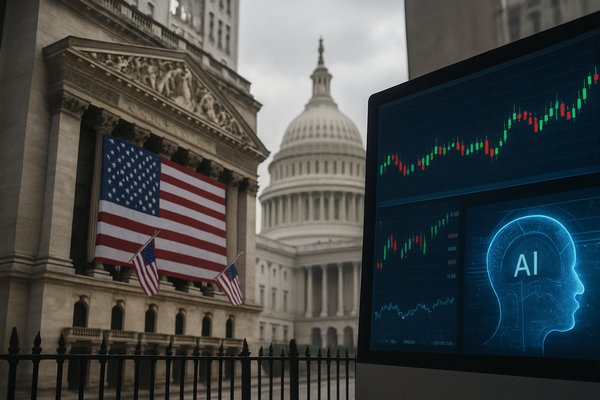
U.S. government shutdown risks are weighing on data flow while Big Tech is racing to fund AI buildouts. The immediate story is tighter visibility for traders and a dollar that is testing three month highs. In the near term, that limits clarity on Fed timing and liquidity. Over the long term, massive AI capex and heavy corporate borrowing will reshape corporate cash flows and may influence demand for Treasury debt. The picture matters for the U.S., Europe and Asia. Emerging markets like Argentina are already diverging, with the Merval hitting records even as local currencies come under pressure.
Market snapshot: what moved today and why it matters
Price action and signals to watch
Wall Street opened the week mixed while Asian bourses posted strong gains. The Kospi pushed to new highs and Argentina’s Merval reached fresh records following political shifts. Brazil’s Bovespa topped 150,000 for the first time. In the United States, equity sector rotation continued with consumer discretionary up and staples under pressure.
The dollar index rose to a three month high and edged toward the 100 level. That strength is weighing on many commodity and EM currencies. Argentine peso weakness and a near 3% slide in bitcoin underscore regional stress and speculative repositioning. U.S. Treasury yields ticked higher at the long end as the curve bear steepened, suggesting investors are pricing more uncertainty about growth and policy.
Big Tech borrowing and AI spending: balance between growth and funding costs
Debt issuance to finance AI rollouts
Major tech firms continue to tap the debt markets as they pour money into artificial intelligence infrastructure. Oracle (NYSE:ORCL) issued roughly $18 billion in September. META (NASDAQ:META) announced its largest ever bond sale of up to $30 billion. Reports put Alphabet (NASDAQ:GOOGL) raising about $22 billion in a multi tranche deal. These moves show lenders remain willing to fund expansion even as capex soars.
Microsoft (NASDAQ:MSFT), Amazon (NASDAQ:AMZN), Meta and Alphabet alone are expected to spend hundreds of billions on data centers and cloud capacity this year. Analysts cite figures in the hundreds of billions for this cycle and estimate that global AI infrastructure spending could reach the low trillions by the end of the decade. For markets, that raises two questions. First, how will large tech borrowing affect corporate cash flows and credit profiles? Second, could heavy corporate issuance compete with demand for U.S. Treasury paper?
The short term effect shows up in bond market technicals and policy pricing. In the longer term, the real test will be whether value creation from AI converts into sustained value capture for investors. Economists and strategists are already debating that distinction and the implications for sectoral returns.
Dealmaking surge: big tickets and stretched valuations
Why M&A momentum persists and what to watch
Deal appetite remains robust as financing conditions loosen. Kimberly-Clark (NYSE:KMB) surprised the market with a near $50 billion bid for Kenvue (NYSE:KVUE), the consumer health spin off. The premium paid and Kenvue’s recent controversies have raised eyebrows, yet the transaction highlights how abundant liquidity is driving headline transactions.
U.S. targeted deals reached $1.7 trillion year on year, up roughly 36 percent and marking one of the busiest stretches since modern records began. That pace supports merger arbitrage flows and corporate activity. For investors the crux is whether price tags reflect fundamental synergies or simply a search for scale in a low rate environment. Either way, big M&A can shift sector leadership and reprice returns when combined with heavy tech capex and corporate debt issuance.
Policy risk and data drought: the shutdown, the Fed and market consequences
How a record length shutdown complicates decisions
The U.S. government shutdown is set to match record durations. That reduces the flow of official data and clouds near term economic visibility. Markets prize timely statistics for pricing risk and for Fed watchers, missing releases complicate the outlook for rate moves. Futures trimmed the odds of a December cut to around two thirds from much higher probabilities last week, reflecting rising uncertainty and the divergence among FOMC members on timing.
In addition, the Federal Reserve’s pivot toward greater use of Treasury bills in funding management may ease supply strains. However, traders are watching liquidity and funding markets for signs that heavy corporate issuance and AI driven borrowing are creating crowded trades. If big tech keeps issuing at scale, it could influence Treasury demand dynamics and push yields in either direction depending on investor appetite.
Near term market drivers to watch
Events that could change the tone for the session ahead
Macro and corporate calendars present clear triggers. Central bank decisions and speakers in Australia and the euro area will set global rate expectations. Final October PMI readings from Japan and Canadian trade numbers will add regional color. On the corporate front, earnings from Advanced Micro Devices (NASDAQ:AMD), Uber (NYSE:UBER), Pfizer (NYSE:PFE) and Spotify (NYSE:SPOT) may move sector flows and provide fresh clues on consumption and enterprise IT spending.
Traders should monitor dollar strength, U.S. yield moves and any headlines on the shutdown resolution. Those elements will interact with M&A headlines and AI funding stories to drive intraday positioning. For global investors, the contrast is stark. Emerging markets that are posting equity gains may still face currency and commodity pressure. Developed markets will trade through the uncertainty with a focus on policy communication and corporate balance sheet developments.
Markets enter the next session with several competing forces. Liquidity and data flow are under stress because of the shutdown. Simultaneously, record corporate borrowing and a wave of AI capex are changing credit dynamics and investor expectations. That combination makes for a session where headlines on policy, large deals and tech funding are likely to dictate price action across equities, bonds and currencies.












